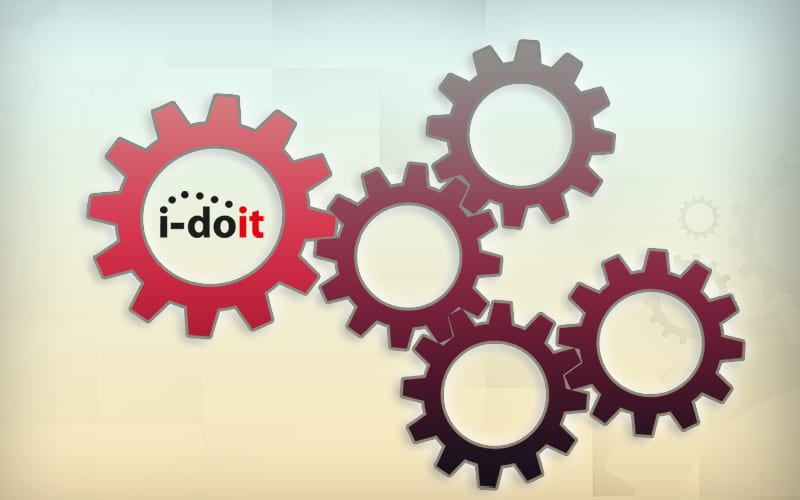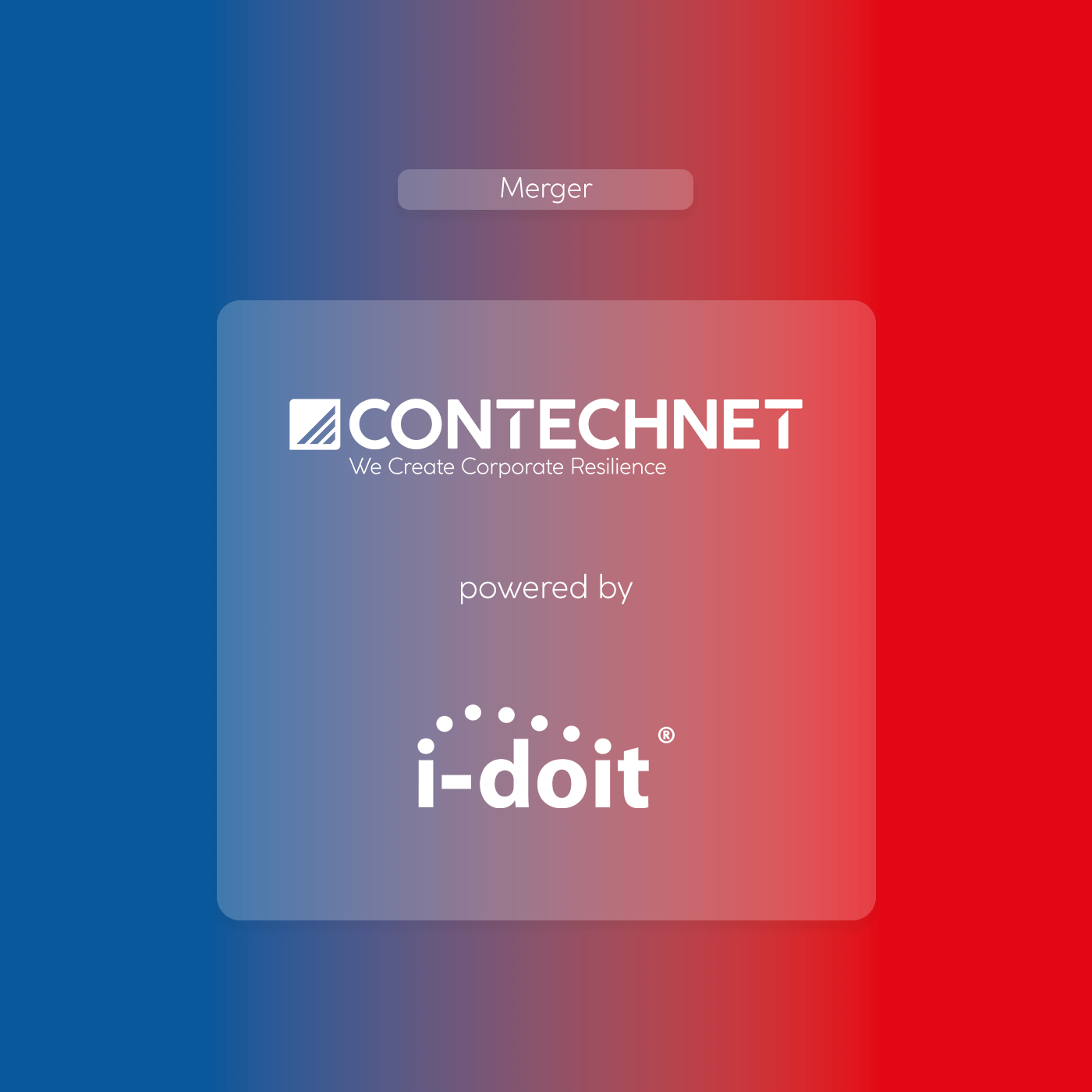Complete documentation already brings many advantages for specialists and managers. All relevant technical information about systems and devices can be found there. The linking of software and hardware, locations and people is also a great support. Especially when it comes to getting a comprehensive view of the IT infrastructure. Asset documentation thus provides the foundation for IT asset management. Significantly more benefits can now be generated from this, e.g. through the definition and modelling of services.
What is an IT service?
A service is a defined performance that consists of various components. Usually, these are not only IT systems. IT services are often complex. They often require active contracts, running software or valid licences for their functionality.
A simple “email service”, for example, consists of:
- Physical server (Server)
- Exchange 2019 (Software)
- Exchange 2019 licence (licence)
- Internet (service)
- DNS (Service)
Basically, a physical server is required on which Exchange 2019 has been installed with a valid licence. In addition, a functioning connection to the Internet and a DNS service are also required. If one of these parts is restricted or defective, this will most likely lead to disruptions in the “email service”. If the server is down, Exchange 2019 is naturally also affected.
If the connection to the Internet fails, this causes no problems for the physical server and Exchange itself. However, emails from outside will neither be sent nor received. Here, too, the email service would be impaired. This also applies to a restricted or unavailable DNS service. If the name resolution does not work, devices in the network cannot be found. Sending and receiving emails will then also be impaired.
The DNS in this example is a separate service. The redundant DNS servers are also located in this service. Our “Internet service” consists of a modem, a router, the contract with the service provider and the WAN line.
The advantages of service modelling
The number of dependencies and relationships, e.g. between systems, people and locations, continues to increase. The modelling of services offers significantly more transparency here. Likewise, it also gives staff more security when planning, expanding and changing IT infrastructures. However, the definition and modelling of services has even more advantages.
1. Better understanding between staff and the IT department
Users speak in services. Few employees will make statements like “I think there’s a problem with our Exchange”. Much more often, they will say on the phone “I can’t send any more emails”. Administrators now simply check the “email service” modelled in i-doit to see if one of the elements has a fault.
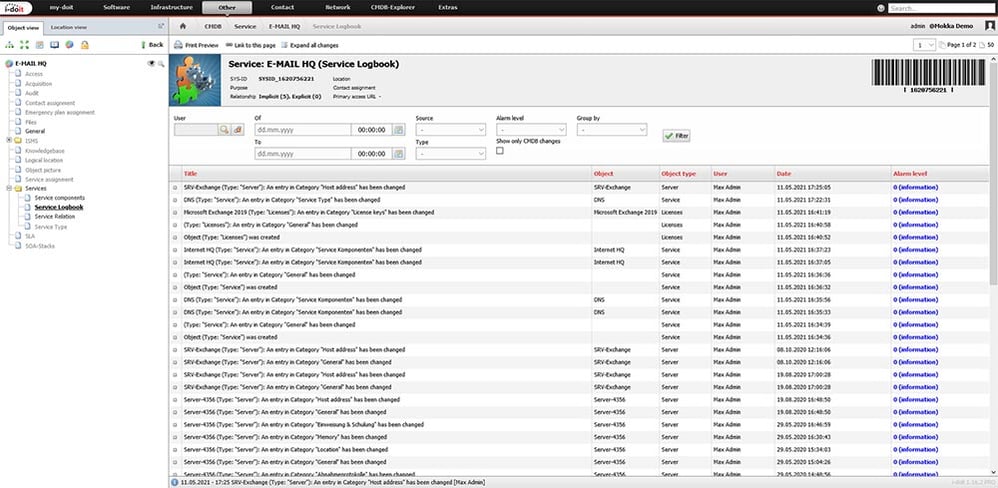 The service logbook records all changes and lists them chronologically.
The service logbook records all changes and lists them chronologically.
At the same time, the administrator can also check the service logbook, in which all changes are listed chronologically. If a unit was last assigned a new IP address, for example, this is displayed in the service logbook. The administrator saves a lot of time in determining the cause of the fault.
2. Audit services and their performance
Auditing of services is important to ensure quality on a regular basis. With i-doit, audits are maintained and checked in a separate category by those responsible. Faults and incidents are recorded and the result of the audit is documented. Various deadline dates are also recorded on the manufacturer and operator side.
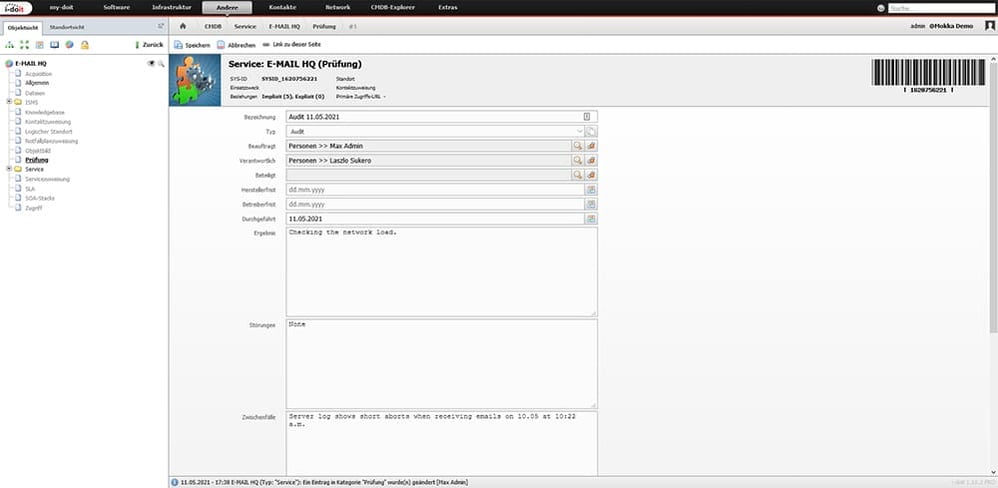 The auditing of IT services can be sustainably documented via the category “audit” and delegated to specialists and managers.
The auditing of IT services can be sustainably documented via the category “audit” and delegated to specialists and managers.
3. Determine and optimise service costs
IT services have precisely defined performance and characteristics. These are associated with a monetary cost. Therefore, in order to check the actual costs of a service, the operating costs for the respective components must be recorded. These are, for example, costs for:
If you know the characteristics and costs of IT services, it is much easier to identify potential savings. It also makes it easier to determine alternative products and services.
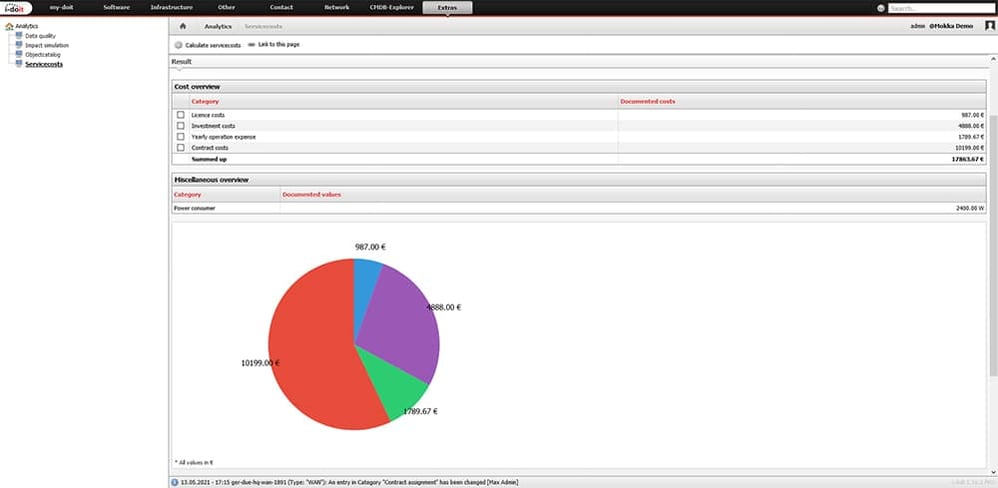
4. Simulate failure of devices and services
“What actually happens if… ?” This is a question that is not only asked by administrators. More and more often, department heads and managing directors are raising this question. How does a failure of devices or entire services affect the infrastructure? With the i-doit pro add-on Analysis, exactly such failures are simulated and the consequences can be estimated. All that is needed is to select an object in the CMDB, e.g. a system, software or complete services. Then the simulation is started. In this example, we simulate how the failure of the DNS service affects the infrastructure.
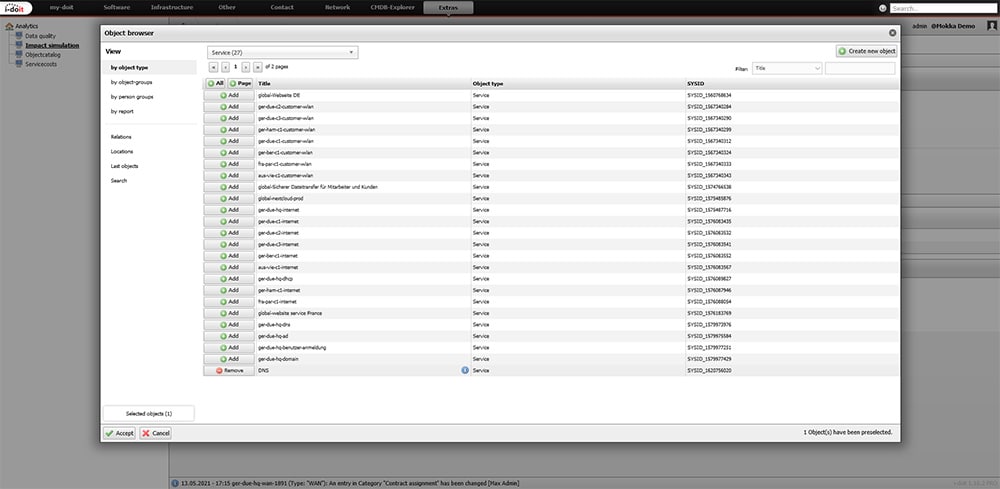 Several objects can be used for the failure simulation. This makes it possible to design very complex failure scenarios.
Several objects can be used for the failure simulation. This makes it possible to design very complex failure scenarios.
The effect of the failure is calculated after the start of the simulation. It is then displayed with the severity of the failure in the overview. In addition, the result is displayed in a tree view to highlight dependencies and relationships between objects.
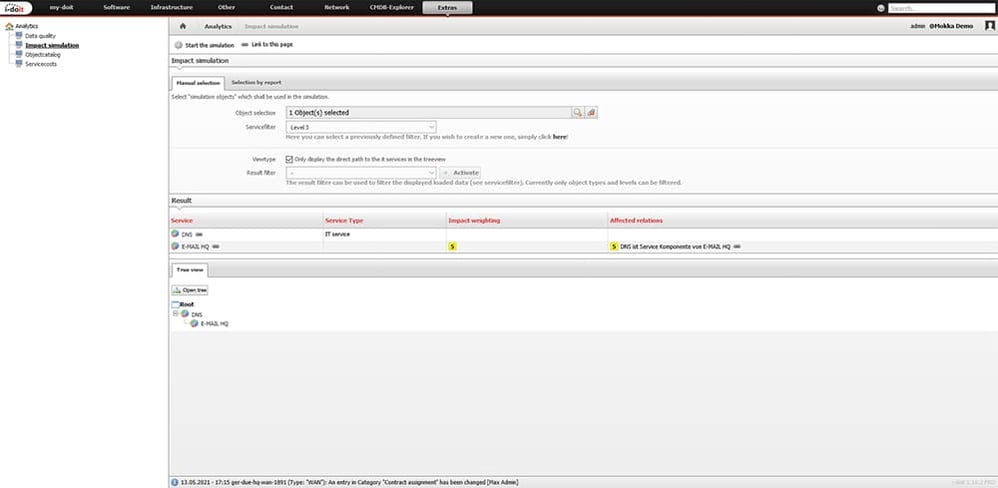 After the audit, the restricted services and systems are presented.
After the audit, the restricted services and systems are presented.
Since the DNS service is a component of our email service, it is now also shown as impaired.
5. Automatic checking of service consistencies
A widget for automatically checking the consistency of services can be set up on the user dashboard. This way, the responsible staff member always has an overview of whether there are any disruptions and whether any action needs to be taken.
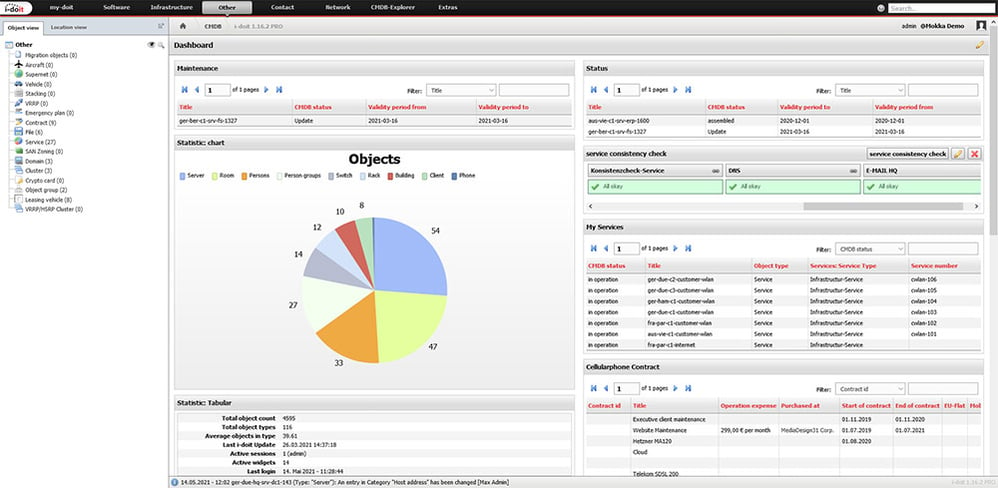 The widget on the dashboard shows users which services are consistent
The widget on the dashboard shows users which services are consistent
Should a system on which this service is dependent be faulty, the service is shown as inconsistent. For our example, we change our DNS server to the state “Defective”. Thus, the service “DNS” is marked as inconsistent. Since our email service needs the DNS service to be able to work without malfunctions, this service is also displayed as inconsistent.
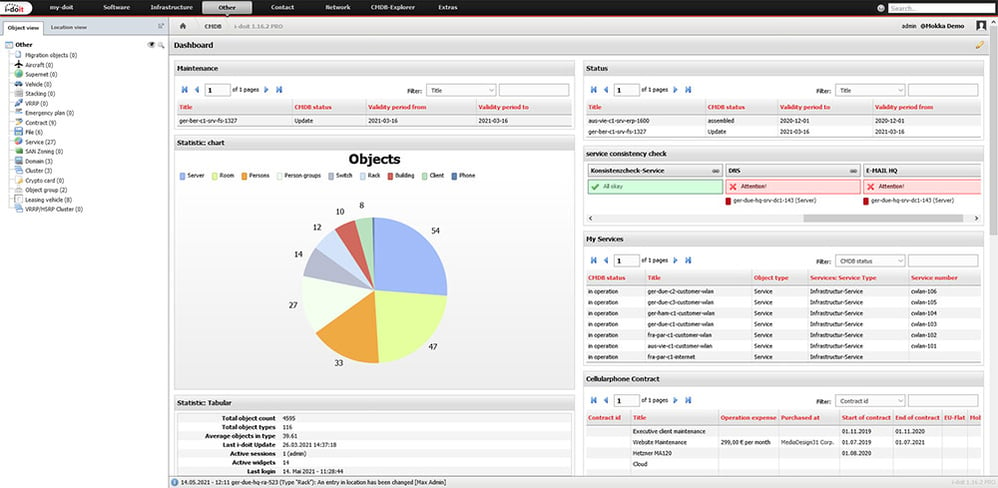 In the case of defective units, the services are displayed as inconsistent.
In the case of defective units, the services are displayed as inconsistent.
Services with i-doit for more transparency in the IT infrastructure
With i-doit you can model your IT services directly with the documented assets within minutes. This not only gives you significantly more transparency, but also allows you to identify dependencies on systems, software, contracts, licences and much more. With the i-doit pro Analysis add-on, you can also completely evaluate the costs of your services without any gaps. In this way you can uncover opportunities for savings. By modelling the services, you can also check which systems can be replaced by cheaper or more efficient ones. Of course, it is also possible to check and audit services with i-doit. These are documented and maintained directly in the object. Get the maximum benefit from your IT documentation.
If you have any questions about i-doit or the modelling and use of services, please contact us at sales@i-doit.com.

